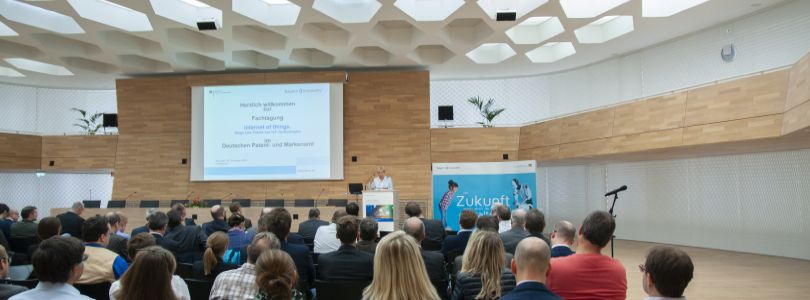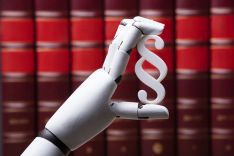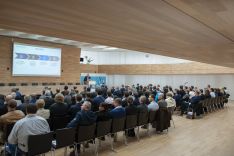Content
IoT Conference at the DPMA

The Internet of Things and the Patent
The "Internet of things", or IoT for short, is currently one of the most important technology trends. It has become "a synonym for the connection between the real and the virtual world," said President Cornelia Rudloff-Schäffer at the opening of the conference "Internet of things. Paths to the Patent of IoT Technologies" at the DPMA. ![]() Bayern Innovativ GmbH had invited more than 120 experts from industry, research and law.
Bayern Innovativ GmbH had invited more than 120 experts from industry, research and law.
The IoT makes things capable of networking, sending and receiving data: Printers independently reorder ink cartridges, networked vehicles transport components driverless, Smart Watches call the doctor when the pulse gets out of sync, robots analyse and repair themselves and order their spare parts via the Internet. "So when 'stupid' things get smart, it's a clear sign that we're heading for a fourth industrial revolution," Cornelia Rudloff-Schäffer said in her welcoming address. "Or better: evolution.
IoT is actually a bundling of technologies: mobile communications, augmented reality, robotics, cloud services, network technologies, production facilities or IoT hardware such as sensors, actuators and gateways. And above all AI: artificial intelligence. "The IoT needs AI," says Rudloff-Schäffer: "Only an intelligent evaluation and control of data processed through the use of AIs will help the networking of things to achieve their final breakthrough“.
Last year, a symposium at the same location discussed the effects and challenges of artificial intelligence in the patent system. The IoT conference was now the continuation, so to speak.
„Internet of everything“

Kevin Ashton is considered the "inventor" of the Internet of Things and its eponym because he applied for the first IoT-relevant patent ("storage system", EP 1185953 B1 ). Today, people, machines, products, sensors, systems and logistics in industry 4.0 communicate and cooperate directly with one another. People are therefore already talking about the "Internet of Everything“ or "Massive Internet of Things" (MIoT), or "Massive Machine-Type Communications (mMTC)".
"IoT is a giant field , so Dr. Oliver Mayer of Bavaria innovative GmbH. A collective term for technologies of a global infrastructure of information societies, which makes it possible to network physical and virtual objects with each other and to let them cooperate through information and communication technologies. This raises a question, says Mayer: "How does man avoid becoming superfluous?
The virtual inventor
Today, for example, KI is preparing to make its own inventions. One of the key questions is therefore: Could AI-generated inventions be patentable? Prof. Dr. Matthias Leistner from the LMU Munich University spoke about opportunities and challenges for the future in the field of IoT and patents. "AI inventions are reality today," said Leistner. He advocated a "normal" patentability possibility for such developments. There is no need to be afraid of a "flood of patents", he says - AI could also be helpful in processing patent applications as well.
Dr. Josef Fleischmann, examiner at the DPMA, reported that current practice might soon be called into question (see also our AI dossier). The "Artifical Inventor Project" had recently filed AI-generated inventions with various patent offices (e.g. EPO, USPTO) explicitly naming artificial intelligence as inventor ("Dabus, creativity machine"), in order to create a precedent.
It is well known that a patent criterion is that an "expert" must be able to reproduce the invention by means of the application. According to Fleischmann, AI applications in the technical field (and these are constantly increasing!) today require "expert teams" rather than "experts", as these are increasingly interdisciplinary.
Fleischmann speaks of "explainable AI" if the working method of the AI is comprehensible (see also our interview). AI often remains a "black box", because it is not transparent. According to Fleischmann, KI is already superior to humans in some areas, such as medical image processing.
Blockchain and consciousness

Prof. Dr. Sevim Süzeroglu Melchiors wants to "raise awareness for the relevance of IP already in teaching". The professor for Digital Entrepreneurship and Financing at the East Bavarian Technical University presented various initiatives and activities at her campus in Regensburg.
Many funding initiatives offer students support for research projects and the spin-off of IoT-based business models. However, the potential for patenting is still "largely untapped," says Melchiors.
Dr. Richard Brunnner of Dennemeyer Group spoke about possible applications of blockchains in the IP area. Among the useful aspects of blockchains for IP management were their transparency and immutability; manipulation was practically impossible according to Brunner. Further advantages are their cryptography, authentication, automatic time stamp and chronological recording of all transactions to prove priority.
Questions of ownership or authenticity and the fight against product piracy are application cases for blockchains in IP management, according to Brunner: They enabled, for example, proof of authorship, authentication of originals against copies or proof of use for trademarks.
Blockchain is an exciting combination of technologies that can be used for registration, tracking and intellectual property protection. Special technological aspects of blockchain technologies are still patentable, says Brunner. Blockchain patents can represent a strategic advantage for companies; "even though there are currently hardly any patent infringement proceedings in this area, some see a patent war brewing".
SEP and connectivity
Iouri Kobiako von Gamm from the patent and law firm of the same name spoke about "Communication standards for IoT and IPR (or patent) challenges". IoT connectivity is driven by standards-based technologies, said Kobiako von Gamm. The patent landscape is particularly complex in the area of IoT connectivity. Many of them are so-called "standard essential patents" or "SEPs".
The legal environment in this area has undergone a number of fundamental changes in recent years - primarily in favour of SEP users, the speaker said. The most important trigger in Europe was the ECJ ruling of 16 July 2015 in the case "Huawei Technologies Co. Ltd v ZTE Corp. and ZTE Deutschland GmbH" (![]() file number C-170/13). According to Kobiako von Gamm, the handling of SEPs (also in the area of IoT connectivity) is now subject to important restrictions and rules.
file number C-170/13). According to Kobiako von Gamm, the handling of SEPs (also in the area of IoT connectivity) is now subject to important restrictions and rules.
3D Printing: Curse and Blessing
A key technology whose great future has already begun and its IP aspects were presented by attorney Dr. Wolfgang Kellenter of the Düsseldorf law firm Hengeler Mueller: 3D printing.
The advantages of the additive production of parts in the 3D printer are obvious: no waste is generated because material is not removed but added. Since there is no unnecessary inner material even for complex products, the parts have a lower weight. Less material is required; prototypes can be produced very quickly, spare parts can be produced "on demand".
But the technology also has great potential to jeopardize IP rights: 3D printing makes it possible to copy protected works with much less effort than traditional manufacturing processes. According to Kellenter, it promotes worldwide infringements because infringing products do not have to travel a distance, but can be printed online anywhere in the world. So do we need new IP rights to address this problem?
Kellenter raised another particularly serious issue: Weapons from the 3D printer. Today, weapons can easily be illegally printed by anyone on the basis of a 3D file downloaded from the Internet. This is a great danger, not only in the USA, but also in our country, as the attack in Halle showed.
The defence of the Thermomix
What are the advantages of the upcoming 5G mobile radio standard? Above all, the much higher speed, the better data transmission rate, significantly shorter signal propagation times and a radical reduction in energy consumption. 5G will be important for many AI applications, especially autonomous driving. Dr. Thomas Gniadek, lawyer at Noerr, talked about patent and licensing issues concerning 5G networks and IoT.
How did Thermomix defend its exclusivity against competitors for a long time? With a "protective wall" of 151 patents! Vorwerk´s IP strategy focused on blocking the competition. - A striking example given by Hans-Gerd Servatius of Competivation Consulting in his paper "Protection of intellectual property in IoT business models". "A good understanding of possible barriers" is important for the right IP strategy, said Servatius.
Keep going, keep going!
Germany's lag in comparison with the state of development of AI applications in other countries was the topic of the final discussion. "Elsewhere" (especially in China) it was much easier to get the urgently needed data to train AI systems. This raised the question of whether data protection is slowing down AI development in Germany. All participants agreed that we are in a "transformation process" that requires a repositioning in the face of tough competition. Germany must not rest on its laurels on the high quality of research and patents, it was said, among other things, and must see the risks as opportunities: "It´s not too late to catch the train yet!".
Pictures: Bayern Innovativ GmbH, iStock.com/phonlamaiophoto, iStock.com/AndreyPopov
Last updated: 19 May 2025




Not only protecting innovations
Social Media